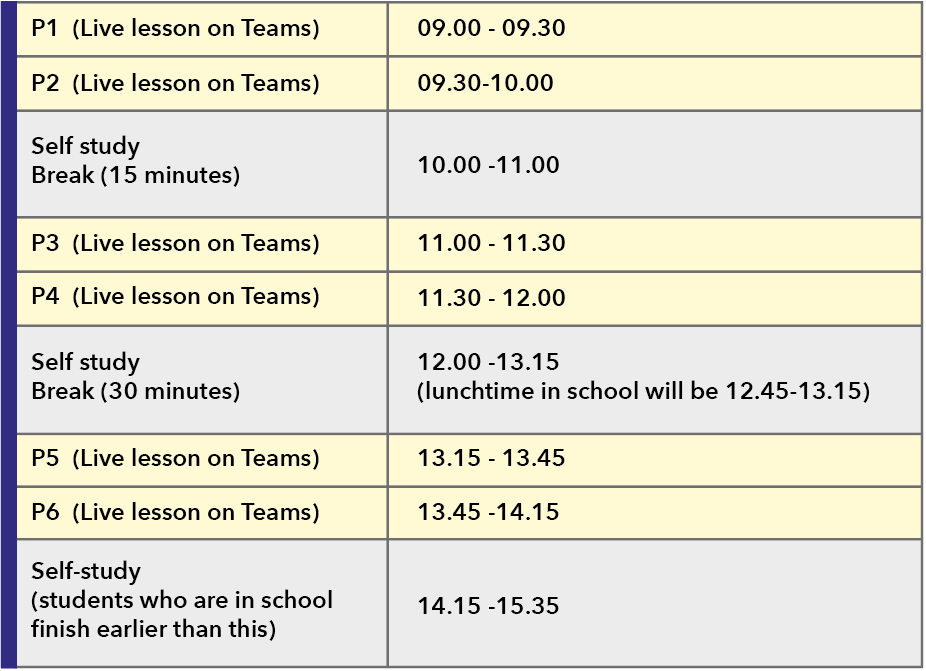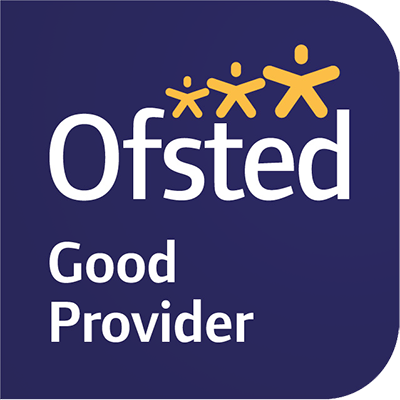Remote Education Provision: Information for Parents of Children at Sandhill View Academy
An Introduction to Remote Education
This information is intended to provide clarity and transparency to pupils, parents and carers about what to expect from remote education if local restrictions require entire cohorts or bubbles to remain at home. For details of what to expect where individual pupils are self-isolating, please see the final section of this page. Our main aim is to keep things simple shown in daily timetable below, but this guidance gives more details and outlines reasons for making the choices we have.
Remote Education: Keeping it Simple
- 3 hours of live online lessons per day
- Approximately 3 hours of ‘self study’ (self study tasks are introduced in live lessons)
The Language of Remote Education
There are different definitions, but these are the ones we will use:
- Remote education: a broad term including any learning that happens outside of the classroom, with the teacher not present in the same location as the pupils.
- Digital education- often known as online learning
- Live online lessons – with a teacher meeting students in a ‘virtual classroom’
- Self study – where students complete tasks set by their teachers, as they would during lessons
- Blended learning: a mix of the above.
There is no evidence yet to suggest that one form of remote education is better than another. Live online lessons have advantages but so does paper-based work. Live lessons allow students to interact with teachers and ask for help. Self-study work allows students to have a break from a computer screen, think deeply and reflect. We will therefore use a combination of these methods depending on the subject and the part of the curriculum being covered. Digital platforms can be excellent for providing instant feedback and encouraging practice of key skills (e.g. MyMaths). We aim to provide a blended approach to remote education.
The Remote Curriculum: What is Taught to Pupils at Home
A pupil’s first day or two of being educated remotely might look different from our standard approach, while we take all necessary actions to prepare for a longer period of remote teaching.
What should my child expect from immediate remote education in the first day or two of pupils being sent home?
Each student can access remote learning in a number of ways, to suit their own home circumstances. Each student has access to virtual, live classes via Microsoft Teams. Learning resources are found in the files section of the Teams classes. Work booklets are available for every subject, should students prefer to have paper copies to work through when self-isolating.
Following the first few days of remote education, will my child be taught broadly the same curriculum as they would if they were in school?
Yes. We teach the same curriculum remotely as we do in school wherever possible and appropriate. However, we have needed to make some adaptations in some subjects (for example, fieldwork in Geography will not follow the usual teaching sequence).
Remote Teaching and Study Time Each Day
How long can I expect work set by the school to take my child each day?
We expect that remote education (including remote teaching and independent work) will take pupils broadly the following number of hours each day as they spend in formal lessons i.e. 6 hours per day.
The timetable sequence will remain the same, although times of live lessons will change during a lockdown. This is because we don’t want our staff or students sat in front of a mobile device/laptop/PC for six hours every day. This would not be good for wellbeing. Lockdown live lesson times are shown below. Students will work independently during self-study times, on tasks that have been introduced and explained during live lessons. Teachers are available during self-study times to respond to questions in Teams chat/posts, or by email.
In the event of a lockdown, students will be sent a letter to explain how to access their learning, this will also be sent via email. Plans will be communicated to parents and carers via the MyEd App, an initial text, and the weekly Headteacher’s Blog. The best way all parents and carers to stay in touch with school communications is by downloading the MyEd app, which is free to download and use.
Accessing Remote Education
How will my child access any online remote education you are providing?
Students can access instructions via the Teams classes they are part of (they have been shown how to do this in lessons in school).
They can communicate with their Teachers in the following ways:
- Within the Teams class, using the posts and chat functions
- Using their teacher’s email address (secondname.first initial@sandhillview.com)
- Through Satchel One (our usual platform for setting homework)
- If you are unsure please contact info@sandhillview.com and you will be given the details you need.
If my child does not have digital or online access at home, how will you support them to access remote education?
We recognise that some pupils may not have suitable online access at home. We take the following approaches to support those pupils to access remote education:
- We have a number of school lap tops and tablets that are available for short term loan
- If you have a device but to not have wifi access, we can give you a free sim card to cover the duration of your child’s isolation/lockdown.
- Heads of year are happy to provide printed work booklets upon request
- Pupils can submit work to their teachers online (using the Teams Assignments function), or on paper when they return to school.
How will my child be taught remotely?
We use a combination of the following approaches to teach pupils remotely:
- Daily live teaching, during three one hour blocks, in line with our remote learning timetable (daily live lessons are delivered using Microsoft Teams)
- Recorded teaching (e.g. Oak National Academy lessons, video/audio recordings made by teachers)
- Printed paper packs produced by teachers (e.g. workbooks, worksheets)
- Textbooks and reading books pupils have at home
- Commercially available websites supporting the teaching of specific subjects or areas, including video clips or sequences
Engagement and Feedback
What are your expectations for my child’s engagement and the support that we as parents and carers should provide at home?
We expect students to attempt to follow their usual school timetable if they are working from home, engaging in all live lessons where possible. We appreciate that this may not always be possible and heads of year are in touch with students who require a different approach, making sure that they have access to additional materials.
How can I support my child with remote learning?
We request that you support us in our aim to continue to provide full-time, high quality education by making sure your child:
- Follows usual school routines (getting to bed at a sensible time, having breakfast and getting washed and dressed before live lesson start.
- Has a quiet area in which to work and engage with live lessons, away from any distractions. Teachers will often ask questions during lessons, asking students to turn on the microphone.
- Has a pen and paper available during every live lesson, so they can take notes/answer questions.
- Talks to you about their daily experiences, so you can let us know.
How will I be informed if there are concerns?
- Lesson 1 on Mondays is our timetabled SMSC (Social, Moral, Spiritual and Cultural) lesson, taken by form tutors within your child’s year group. We use lack of attendance at this lesson as the basis for weekly well-being calls. If your child does not attend this lesson, you will receive a call from their form tutor to see how any issues can be resolved.
- Each teacher takes a record of attendance in every live Teams lessons. They also keep a record of engagement beyond the live lessons, using data analysis software within Microsoft Teams. These records are passed on to Heads of Year who make telephone contact with parents of students who have not engaged in learning.
How will you assess my child’s work and progress?
Feedback can take many forms and will not always mean extensive written comments for individual children. For example, teachers may set whole-class feedback or use quizzes marked automatically via digital platforms (e.g. using MyMaths, Microsoft Forms quizzes or Microsoft Teams Assignments) . Our approach to feeding back on pupil work is as follows:
- We recognise that home learning is challenging; feedback for all submitted work starts with praise.
- Our usual approach to feedback provides students with a way to improve their work (using the phrase ‘even better if…’ then giving students an opportunity for ‘green pen improvement’). During lockdown, teachers will use their professional judgement of an individual student as to whether or not this is appropriate. Our foremost aim is to keep students engaged in learning, using encouragement and praise as a motivator. If there is evidence of misunderstanding, teachers may choose to follow our usual approach. Alternatively they may use misconceptions or errors to teach a lesson in a different way, or give whole class feedback.
- Pupils can expect to receive feedback more frequently in some subjects than others, linked to how frequently they receive the subject on their timetable, for example pupils will receive feedback in maths and English, more often than they will receive feedback in history or geography.
Additional Support for Pupils with Particular Needs
How will you work with me to help my child who needs additional support from adults at home to access remote education?
We recognise that some pupils, for example some pupils with special educational needs and disabilities (SEND), may not be able to access remote education without support from adults at home. We acknowledge the difficulties this may place on families, and we will work with parents and carers to support those pupils in the following ways:
- Each member of staff is our SEND team acts as a mentor to students with SEND, they know each child and make contact with them each week in school.
- This weekly contact during lockdown will continue but by telephone.
- Mentors will discuss with families, liaise with your child’s Head of Year and teachers, to communicate how best to support delivery of remote education.
Remote education for self-isolating pupils
Where individual pupils need to self-isolate but the majority of their peer group remains in school, remote education will differ from the approach for whole groups. This is due to the challenges of teaching pupils both at home and in school. In this instance, pupils can access online learning through the Teams group for their year group (all curriculum resources are available and are held in ‘weekly files’ so students can see the work that came before if they need to backtrack). Pupils may work according to their timetable or may follow a more flexible approach, as long as they have completed the work required by the end of the isolation period. Work booklets are available should this approach be preferred. Students should submit questions about work to their teacher by email, they can submit work completed by email (by attaching it as a document or by taking a photograph of their work booklet). Feedback will be given by email. Alternatively, they may return their work booklet when they return to school and feedback will be written on the booklet.
Staff and pupil absence
If your child is ill and unable to attend their live lessons, please inform their Head of Year, who will then contact their teachers to explain that they are unable to attend and complete work.
If a member of staff is unwell, or unable to attend a ‘live online lesson’ for any reason, the usual absence reporting procedures should be followed. In the case of a short term absence, the live lesson may be cancelled and self-study tasks will be set in the usual way. If the member of staff is likely to be absent for a longer period of time, then a new member of staff will be assigned to the class, to allow live lessons to continue according to the planned timetable.
How do we monitor the quality of remote education?
Remote education is a relatively new experience for us all. While we are confident that our provision is high quality and in line with the best provision being offered in to schools in the region and across the country, we are always keen to improve and as such, we welcome feedback from parents, carers and students. Our Curriculum Leaders carry out weekly meetings with all teachers to gather feedback on what has worked well and to discuss any emerging issues. They also they have access to all virtual classes so can ensure a high standard of work is being set by teachers on a regular basis. We will continue to conduct regular parent, student and staff surveys about what is working well, giving frequent opportunities for issues to be raised so that we can deal with them as they arise.





